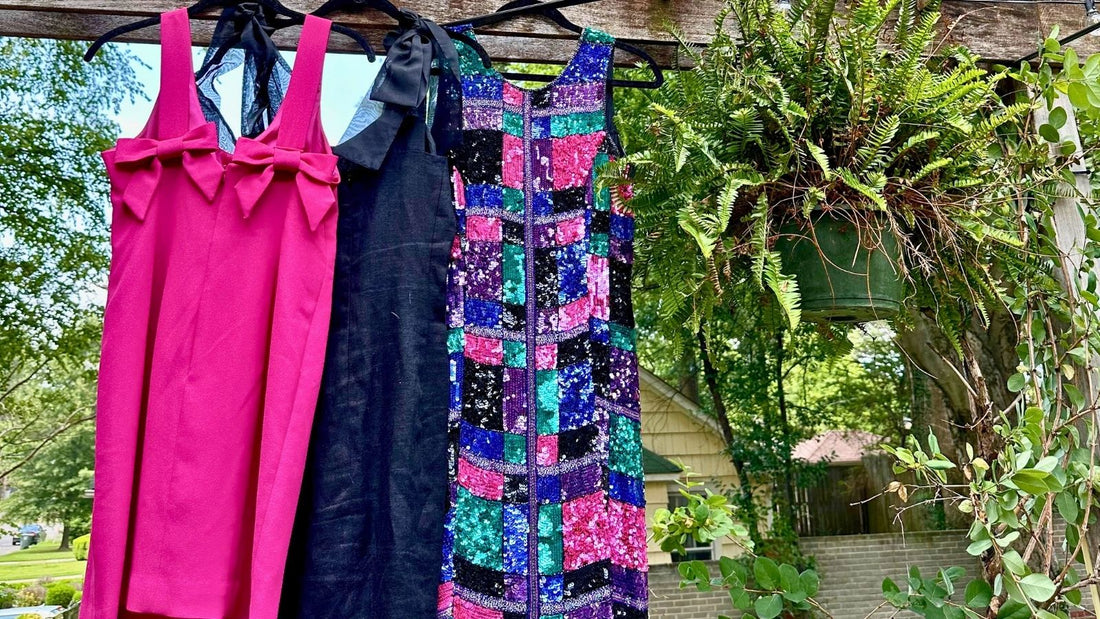Let me start by saying, I have ruined vintage garments. Absolutely ruined them. There is almost nothing that gives me more anxiety than vintage cleaning and soaking day, because I know that there is still a chance that everything could end disastrously. As I've gotten more experience, the disasters are fewer and further between, but cleaning 70-year-old garments is still tricky business.
Here are a few basics I've learned about cleaning vintage in my years of trial and error. This is enough to get you started, but if you want a deeper dive stay tuned for Cleaning 102.
Cleaning by Fabric
Cotton
Cotton is the fabric of our lives for a reason. It's durable, breathable, and easy to care for. Some say it's "sustainable," and while yes it is a natural fabric, it does require a great number of resources to produce. Cotton can often be tossed in the washing machine.
Polyester
I've sung polyester's praises before for its durability and ease of care. But then I remind myself that polyester is basically plastic. It may be wrinkle-resistant and easy to wash, but it does not biodegrade. At all. That said, polyester is unavoidable in vintage, especially if you're fond of the 1970's!
Polyester garments can almost always go straight into the washer. Because of its wrinkle resistance, especially with heavier double knits, it's ready to go right out of the dryer. It's the fabric I am the least careful with. The only caveat is not to get it too hot, or it can literally melt!
Rayon
Don't throw it in the washing machine. Just don't. It's like a Gremlin, don't even get it wet. It will still shrink like hell and turn into a child's dress. You can dry clean it, but I usually just steam rayon. Every once in a while, there's rayon blend with instructions on the care tag to wash on gentle. I've followed those with newer garments and been fine, but older rayon don't play.
There are ways you can stretch and essentially re-construct a rayon (and wool) garment once it's wet, but honestly, I've never had the patience to attempt that. I'd rather take it to the dry cleaners before I play Stretch Armstrong with something that may not even end up being wearable again.
Silk
Older silks must be handled with much care. Fabrics I've had the least success cleaning have been 1920's and 30's silks. They've essentially disintegrated on me. If you have something that old that's stained, it may not be salvageable. Newer silks can often be hand washed. I also spot clean silk as much as I can, as to not stress the fabric with a full soak.
Cleaning by Method
Machine Wash
If you're scared to machine wash any of your vintage clothes, I appreciate your caution. But also remember that washing machines (and even some detergents) have come a long way since that garment was originally constructed. That said, machine washing will break down fibers faster than most other methods. There are some vintage purists that say never to put any vintage in the washing machine ever, but I frankly don't have time for all that hand washing. Especially when it comes to my personal vintage collection.
I machine wash most casual wear, depending on fabric and construction, from the 1970's and later. That is a sweeping generalization, but for those decades I'm mostly talking denim, polyester, cotton sweatshirts, etc, that can absolutely withstand an agitator. Typically these will be already marked as "machine washable." Fun fact, the early 1970's is actually when clothing care tags became ubiquitous, checking tags is another way to date your clothing!
I do always opt for a mild, fragrance-free detergent like All Free & Clear. I want to be mindful of customers who may have sensitive skin, but I also don't want to impart any detergent smells in clothing that may be polarizing. I usually use both wool and plastic spiked dryer balls in lieu of dryer sheets, both because they are fragrance-free and because dryer sheets are bad for your clothes and bad for the environment. Sometimes I hang things to dry, but I will often use the machine instead on the lowest heat setting to save time if I'm drying multiple items (timed dry of ~2 hours, low heat).
Hand Wash
I consider hand washing to be a quick wash in the sink with some detergent, usually Woolite. I use this mainly for sweaters and only if it says so on the care tag. I do own some Eucalan, which is a rinse-free fine fabric wash. Frankly, it sounds like laundry voodoo to me, because how do you not rinse it?! I haven't used it yet, but as I start cleaning more sweaters in the cooler months, I will report back!
Hand washing usually means laying flat to dry which usually means my office is then covered in towels and sweaters (even sometimes portable fans) unless it's a nice day outside. Care tags often say "do not wring," but impatient me has been known to stick it to the man and gently twist my sweaters. I'll sometimes use the roll up method with the towel to make a sweater burrito and expel some of that extra water for faster drying.
Don't hang knits to dry on hangers because they will develop shoulder nipples. You know what I'm talking about.
Soaking (Intense Hand Washing)
Soaking, aka intense hand washing, is when I soak a garment in a bin or the tub to release tough stains or discoloring. Assuming the material allows it, anything lightly colored from the 1950's or earlier that's yellowed and dingy is probably going to need multiple soaks.
For my basic soak, I mix maybe 1/4-1/2 cup of Biz with hot water and submerge the garment for a couple hours (or usually, honestly, whenever I remember to pull it back out or whenever I have a break). I typically stir the garment around in the mixture from time to time with a wooden spoon. I have also seen people weigh garments down with various household items, which I think is really smart!
Usually, once you submerge a garment into the soak, the water will immediately discolor. You will be surprised at what a little Biz can lift out--cigarette smoke, sweat, just general dirt--it can get gross. I will soak something as soon as the water is pretty clear, but I usually don't have the patience for more than about 3 times.
If something is particularly stubborn, I'll use bleach. I usually only do this if I feel like there's zero risk I will F it up. Because bleach scares me. When in doubt, however, do not mix bleach with anything. Just use it on it's own because getting that 1960's dress spot-free is not worth huffing some fumes and killing brain cells. Or I don't know, maybe if it was a really cool Courrèges...
I also use Retro Clean to soak more delicate garments and OxiClean to soak "tougher" ones. Stay tuned for the Cleaning Vintage Clothing 102 to learn when and how I know to use which soak method.
Dry Clean
I'll be honest, I almost never have things dry cleaned for Blue Suede Vintage. First, it's horrible for the environment. Some cities do, but unfortunately, Memphis does not have the option of a more eco-friendly dry cleaner. Second, it's a control issue. I'd rather ruin something myself than hand it over to someone to ruin for me. Of course, I'm also trying to keep expenses down, so if I feel like I can clean it myself, I'll do that before I pay a dry cleaning bill. If a care label says "dry clean only," more often than not, I'll steam it instead.
Steaming
I have a garment steamer that I use ALL the time. Not only does it refresh clothes and remove wrinkles, but it also kills germs. If you're icked out about potentially wearing a dead person's clothes and inheriting their germs, you may want to invest in a good steamer. A word of caution, especially when you're dealing with particularly old garments, steaming can release lots of funky smells from fabrics. If you have an outdoor outlet or good extension cord, you may want to consider steaming outside.
Finally, always use distilled water in your steamer. I've thrown caution to the wind before, used regular tap water, and learned the hard way that the minerals in tap water WILL clog your device if you use it frequently enough. Unclogging it is a big ole pain in the ass that it's better to just avoid.
Those are the basics that should get you started with cleaning your vintage garments at home. In "Cleaning Vintage Clothing 102," I will dive even deeper into laundrydom by discussing my worst nightmare--color bleed, when to use which detergent or soak, and how to alleviate mysterious yucky smells from old clothes.
Send me a message if there's anything else you'd be interested in reading about.
Shop Blue Suede Vintage online 24/7.
Shop the retail location Saturdays & Sundays 12-5pm if you're in the Memphis area. Or we're open Mon-Fri by appointment.
 Casey O'Rourke, owner of Blue Suede Vintage, has been sourcing and collecting vintage clothing for over 20 years. She started selling her collection online through Instagram in early 2018, and Blue Suede Vintage (or, "BSV") grew from there. The retail location of BSV opened in the historic Crosstown neighborhood of Memphis, TN in 2022 and is filled with Casey's favorites from the 1920's to the early 2000's.
Casey O'Rourke, owner of Blue Suede Vintage, has been sourcing and collecting vintage clothing for over 20 years. She started selling her collection online through Instagram in early 2018, and Blue Suede Vintage (or, "BSV") grew from there. The retail location of BSV opened in the historic Crosstown neighborhood of Memphis, TN in 2022 and is filled with Casey's favorites from the 1920's to the early 2000's.


